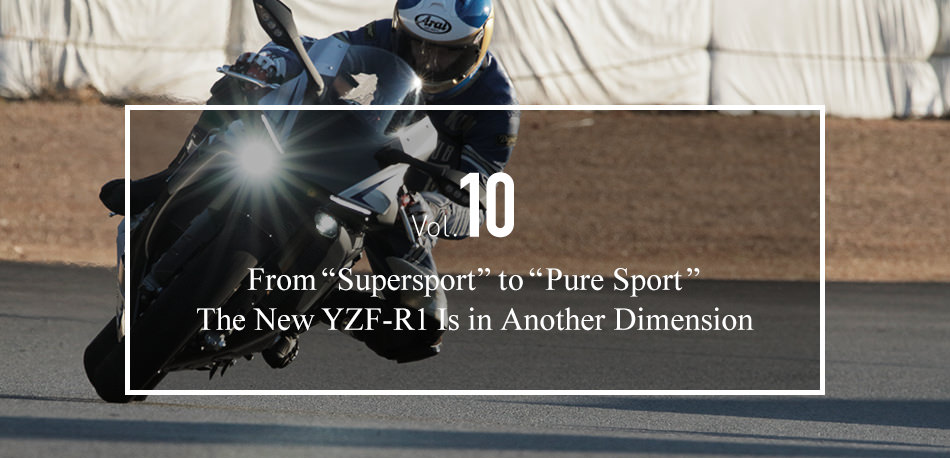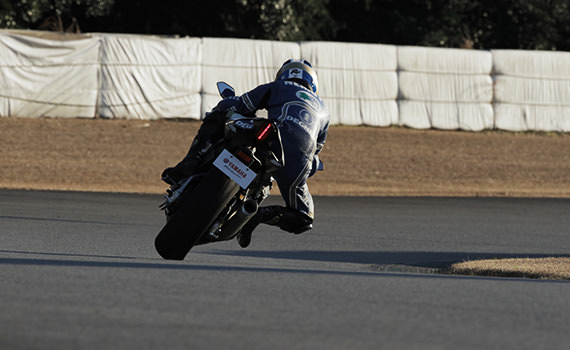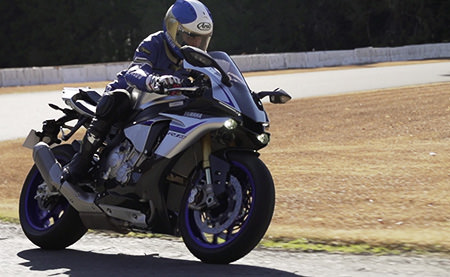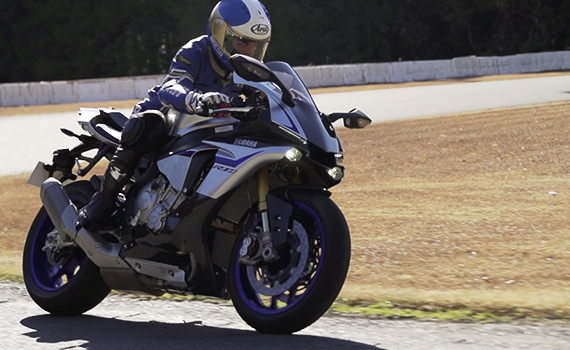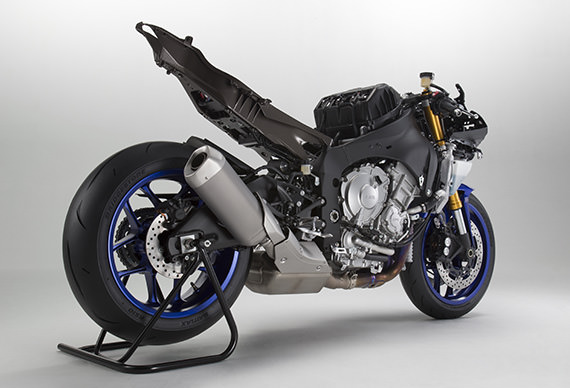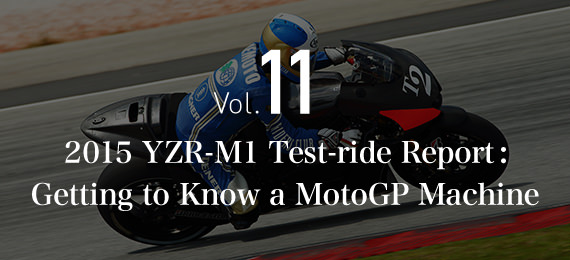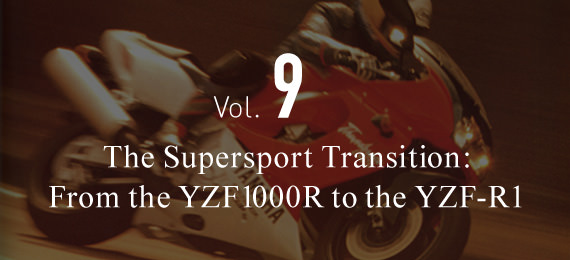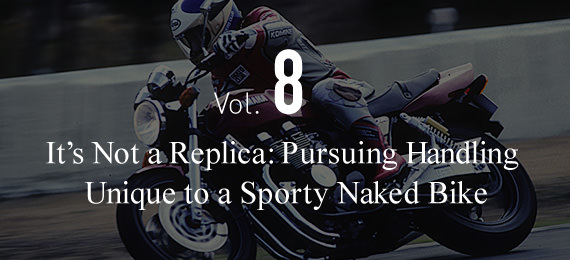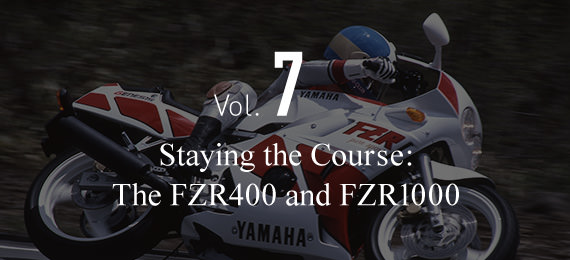Handling Performance in Difficult Situations Revealing a Race Machine Pedigree
(Return to Part 1)
With a motorcycle’s suspension, if the damping force is too firm, it makes the handling feel heavy when going through a series of corners. If you soften the damping force, the handling feels lighter, but in order to provide an additional feeling of stability, a proper degree of moderation and balance must be found between the two extremes. However, with the R1M’s Öhlins Electronic Racing Suspension (ERS), the system reacts to the amount of deceleration, changes in chassis attitude and motion, the degree of acceleration generated via the throttle, etc., and automatically adjusts the damping accordingly for each situation to provide linear transitions into the ideal suspension settings in real-time.
This is felt most clearly in a hairpin turn. On Yamaha’s Fukuroi Test Course, you first enter a right-hand bend as you approach the left-hand hairpin, so the machine is leaning to the right as you decelerate. Then, you bring the machine upright momentarily and brake for the last time [before entering the hairpin], and even if you go harder on the brakes, the system prevents excessive nosedive, so the resulting absence of forward lean (pitch) at the start of the left-hand turn enables you to enter it like a normal turn using the rear wheel [and the throttle]. Thanks to this model’s crossplane crankshaft engine, the engine braking is steady and there’s none of the heaviness you feel resulting from residual inertial forces just before you enter a lean. At this slow speed with the throttle closed, the system softens the damping force to allow light, smooth and steady cornering.

But, the biggest surprise of all came when I opened up the throttle [to exit the turn]. In a hairpin turn where the machine is already somewhat unstable because of the slow speed, having throttle response that is even a bit too sharp when you open it can cause the machine to sway. That’s why riders carefully open the throttle to feel and smooth out the initial transmission of drive force. However, in hairpin turns, this action on the R1M is incredibly smooth—thanks again in part to its crossplane engine—and before you know it, the rear wheel is already gripping the road with powerful traction. I realized that opening up the throttle more and a bit earlier would actually make it easier to take advantage of the rear wheel gripping the road and use it to get through the corner faster.
The more laps I rode, the more I began to get used to the machine’s potential to react for my benefit in different situations. Before long, the tension I had felt before the start of this test ride had disappeared and I gradually felt emboldened to try riding more aggressively.
Since this was a test course, I tried fully opening the throttle mid-lean as I was going through the mid- and high-speed corners; I was enthralled by the feeling of the rear wheel holding a small slide and the bike accelerating out of the turn.
The one thing that I couldn’t enjoy, however, was the nonstop anxiousness that gripped me when I shot like an arrow down the long, downhill main straight. The world at speeds around 300 km/h is something else. No matter how low I got down behind the windscreen, while it did block the wind pressure from the front, I could still feel the tremendous force of the wind pulling my head and back backwards. I clung to the handlebars and had to keep everything above my hips constantly tense. This experience made me painfully aware that the old notion of the main straight being the place to let your body recover from muscling the bike through the turns was no longer valid in this day and age of high performance.
A Yamaha Quality: Electronics in Sync with the Rider’s Perceptions
Incredible! That was the only word I could find to describe my test-ride experience as I began my interview with Akira Tanaka, a senior engineer in Yamaha’s [track] testing group for sport and supersport bikes, to discuss the development philosophy behind this new era of Yamaha Handling. I covered the development of the first-generation 1998 YZF-R1 in Vol. 9; Yamaha had recognized the appeal of the extremely sharp handling of its rival’s machines while designing their own supersport machine based on Yamaha’s different methodology, and as everyone knows, the R1 went on to win devoted fans all around the world. But, Yamaha’s efforts to reach new levels of perfection in this category didn’t end, and their machines continued to evolve. By 2000, they had already released the 2nd-generation R1 with a full range of improvements from the chassis to the engine, and that was quickly followed in 2002 by the 3rd-generation R1 adopting fuel injection and revised chassis balance. This evolution reached its 8th generation with this 2015 model.
Back in 2009, with the development feedback of the crossplane engine on the YZR-M1 MotoGP machine as a factor, Yamaha had focused its sights on yet a new extreme of performance. Tanaka spoke about the development process for the new R1 that resulted in what could be said to be a dramatic and innovative evolution of its handling overall.
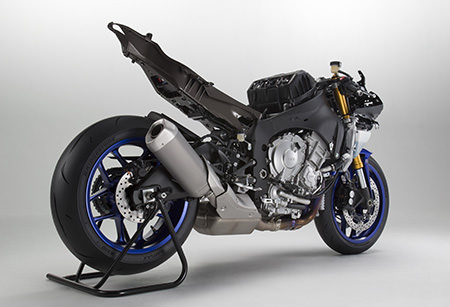
Newly designed aluminum Deltabox frame (YZF-R1)
This new frame inherits Yamaha’s engineering philosophy for its MotoGP bikes. Its superb balance of longitudinal, lateral and torsional rigidity works together with the engine’s characteristics to achieve linear and class-leading performance. The controllability and outright stopping power of the brakes has also been significantly improved.
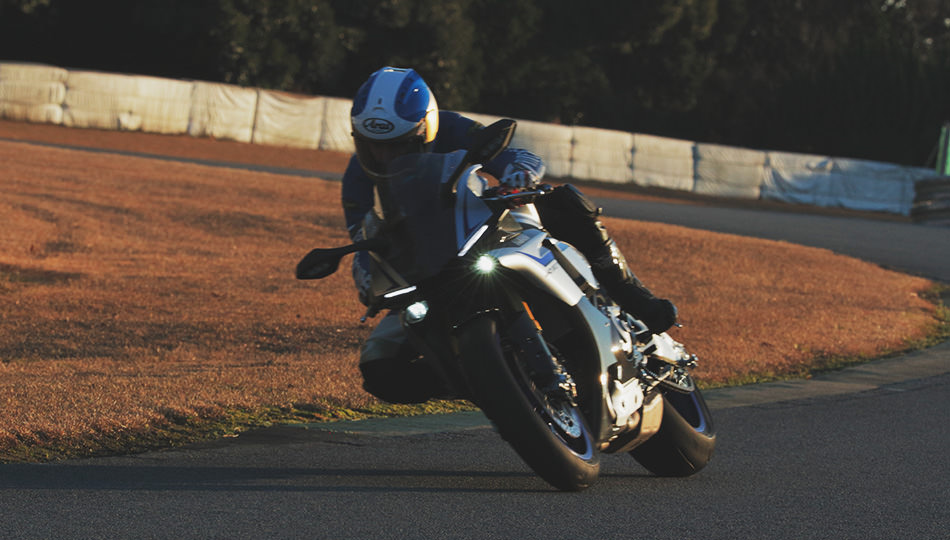
As is mentioned by Tanaka in the video, the development for the new R1 began with the development team members actually test-riding the YZR-M1 MotoGP machine. From that experience, they started to pick up on the elements that made the M1 so easy to ride, to the point that they could even get an idea of the kind of riding that only MotoGP riders are capable of. Though a MotoGP bike appears to be a monster machine that requires tremendous courage to even attempt to ride, in actuality, the team was able to confirm that the M1 was developed with a specific focus on finding ways to make all aspects of its transitional characteristics—the way its performance characteristics change when power is applied or from chassis movement—as easy as possible for the rider to get used to. Tanaka said that it was a perfect case of “you can’t really know a bike until you ride it yourself.”
In order to recreate these qualities of the M1 on a production model, they had to completely revise the engine’s basic design, not only from the standpoint of power output characteristics and compactness but also everything from its shape in relation to chassis behavior to its mounting position.
With the chassis also, they had to revise everything from the alignment required to [the frame’s] rigidity balance to accommodate the bike’s acceleration and deceleration capabilities. Then they had to actually test-ride it and fine-tune all aspects of its design and performance.
A critical component in this process is the Yamaha Ride Control (YRC) system that allows adjustments to things like engine characteristics according to riding conditions. For details about YRC, I would like to ask readers to refer to the reports in motorcycle magazines, but in short, it is technology that uses information that takes into account engine rpm, the gear in use and degree of throttle opening as well as signals from gyro sensors and g-sensors to detect machine motion with six parameters (pitch, roll and yaw motion and longitudinal, lateral and vertical motion). In addition to this, the R1M comes with the aforementioned ERS and the Communication Control Unit (CCU) that lets the rider choose and modify a variety of settings manually to let you experience the kind of amazing riding performance I just described however you want.
When it comes to discussion of devices like these, one might imagine that thorough analysis would reveal all the answers, but that’s not the case. For a company like Yamaha that has never ceased its pursuit of handling performance in tune with rider perceptions, analysis is important, but the degree to which each setting adjustment should affect the bike has been decided with a constant priority on synchronizing the results with human perceptions.
For example, where a rider feels uncertainty or is dissatisfied with a bike’s performance will differ depending on individual skill and experience. A lot of the track testing time and effort was spent on repeating tests as much as possible in anticipation of this. Tanaka said their tests concentrated on finding performance that would fit a wide range of users, from professional riders to sport-riding enthusiasts, so that they could ride just as they wanted with as little anxiety and response time-lag as possible.
But no matter what aspect of the machine’s performance is on the table, test riders always end up using expressions like “just a tad” or “soft and smooth” to describe the small amount of time-lag they feel is necessary, and to arrive at the conclusion that this lies in the “flavor” of a bike’s transitional characteristics is very much like Yamaha. It pleased me to hear how faithfully they stuck to the traditional Yamaha philosophy that, no matter how much high-end performance they are after, it’s no good if the machine makes the rider feel that they are being taken for a ride instead of the other way around.
The thought that this philosophy holds true with the YZR-M1 MotoGP machine as well is something I think that everyone—including myself—doubt. But then, I was told that it would be possible for me to actually ride the YZR-M1; I couldn’t believe what I was hearing. It sounded like an incredible opportunity, and it actually happened.
(Continues in Vol. 11)
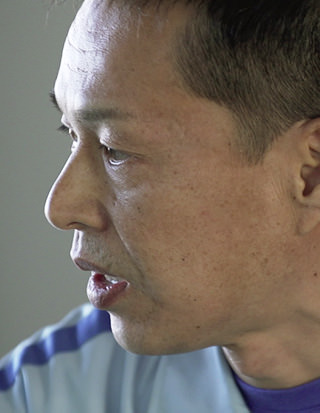
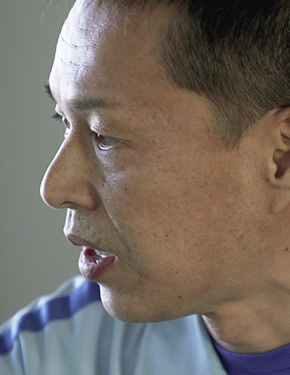
Akira Tanaka
Senior engineer in Yamaha’s testing group for sport and supersport bikes
He is a development test rider who has been responsible for the overall handling performance of numerous YZF-R1s. He played a leading role in the Iwata Racing Family, Yamaha’s company team that competes in the All Japan Road Racing Championship and the Suzuka 8 Hours.


